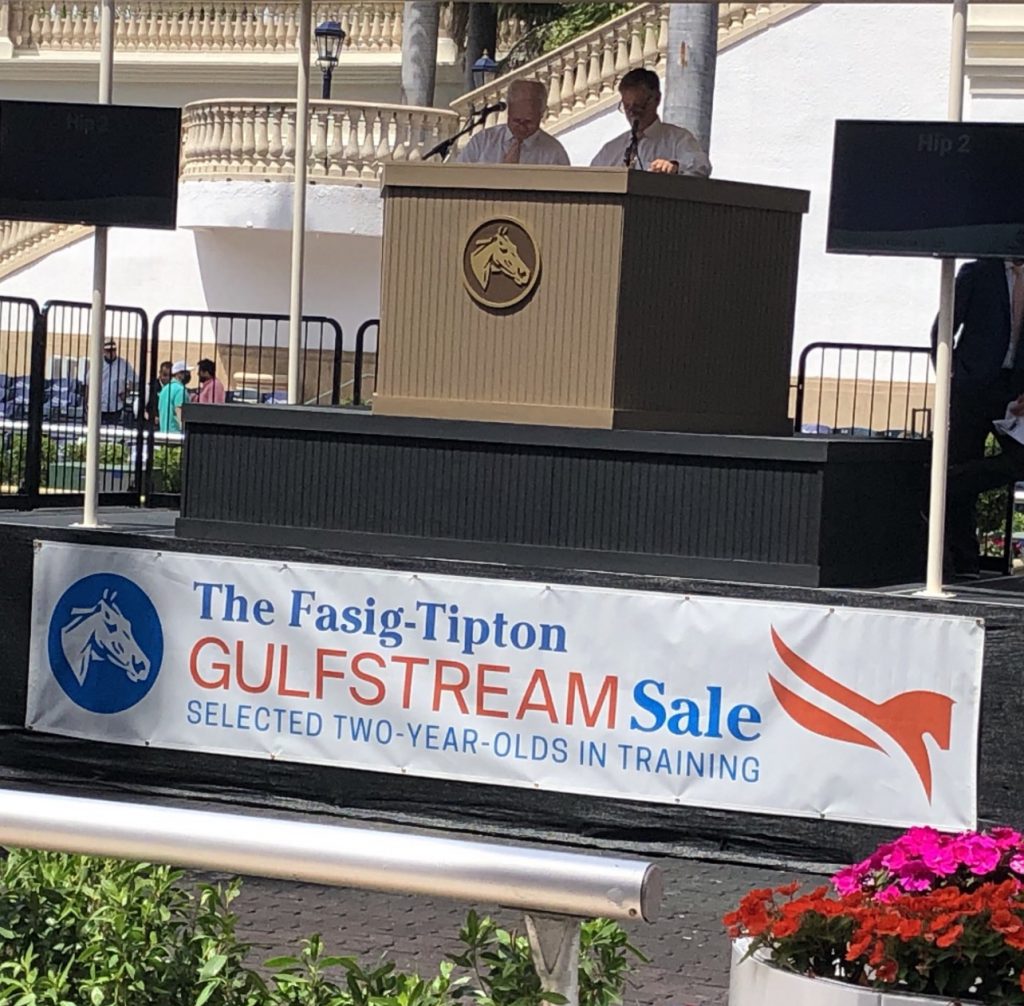
Fasig-Tipton’s annual two-year-old sale at Gulfstream is typically the highlight of the juvenile auction season: the flashiest pedigrees, the best physicals, the most impressive breezes. The F-T Gulfstream sale catalogues under 1% of each year’s foal crop, but it’s a pretty elite 1%. So, breeders and pinhookers were looking to this year’s sale, held on Wednesday, to give a sign as to where the overall market might be headed in general, and where the top of the stallion-prospect market might be headed in particular.
Given the disaster that was last year’s two-year-old market, with Gulfstream and other sales cancelled by the pandemic and the schedules for the remaining auctions reshuffled, this year’s results suggest a return to something like a “normal” market, albeit with a couple of caveats. Overall, this year’s sale grossed $25.4 million; that’s less than the record-setting $29.1 million in 2019, but ahead of the $23.5 million back in 2018. Of the 186 horses in the catalogue, 67 sold, another 38 failed to meet their reserves, and 81, nearly half the total, were scratched before going into the auction ring. That high level of scratches is pretty typical for the Gulfstream sale, where consignors who don’t think their horses will draw big bids – whether because of physical imperfections or slow breezes – still have lots of chances at the later sales. For the 67 horses that did sell (36% of the catalogue), the average price was $387,507, and the median was $300,000. Those numbers, again, were well below the records set in 2019, but in line with the results from the years just before then.
Three horses brought more than $1 million. The sale topper, a Nyquist colt from the family of Grade 1 winner Victory Ride, was the only horse in the sale to breeze an eighth of a mile in less than 10 seconds, on a Gulfstream track that was significantly slower than the one at Ocala, where more than two dozen horses hit 9.4 in last month’s OBS auction. The Nyquist colt drew a bid of $2.6 million from Ireland’s Coolmore colossus, about whom more later. Coolmore also went to $1.3 million, the sale’s third-highest price, for a colt by their own stallion, Uncle Mo, a full brother to Grade 1 winner Dream Tree. Second-crop sire and Kentucky Derby winner Nyquist, not so coincidentally, is also son of Uncle Mo, so Coolmore is definitely doubling down on its stallion bets. (The second highest price of the sale was $1.7 million, for the unfortunately named Needmore Guns, a son of freshman sire Gun Runner out of a Flatter mare who won just about everything there was to win in Ohio during her racing career.)
Coolmore has a business model that few in the industry can imitate. Each year, they spend on the order of $40 million for stallion prospects, looking for yearlings and two-year-olds with good looks and good pedigrees, and, in the two-year-old auctions, fast breezes. If just one of those prospects turns into a multiple Grade 1 winner, he goes on to a stallion career that typically features more than 200 mares each year, plus, often, a southern hemisphere breeding season as well, recouping all of Coolmore’s investment in that year’s crop of prospects in just a very few breeding seasons. The key is being big enough and having enough working capital to be able to consistently buy at the top of the market and to buy enough so that, on average, one or two each year will emerge as very successful stallions. Sometimes (Uncle Mo) it works; sometimes (The Green Monkey) it doesn’t, but over the years, Coolmore may well be the most profitable entity in racing and breeding.
But that model may not last beyond this year. The Jockey Club has established a 140-mare breeding cap, which will apply to all stallions born after 2019; that makes this year’s two-year-old crop the last to have unlimited breeding prospects. Coolmore principal Michael Tabor said after the sale that the breeding cap is likely to end his company’s willingness to go to seven figures for potential stallions. In addition to purchasing two of the three million-dollar horses this year, Coolmore had bought the $3.65 million sale topper and four of the six million-dollar horses back at the 2019 Gulfstream sale. So, it’s clearly the major force driving million-dollar bids. Coolmore, by the way, through its US affiliate Ashford Stud, has joined with two other big stallion operations, Spendthrift and Three Chimneys, in a lawsuit to overturn the Jockey Club rule, but Tabor’s suggestion that its big-spending days are numbered implies that even he doesn’t think much of the lawsuit’s chances. If Tabor’s prediction (or is it a threat?) comes true, we may have seen the last million-dollar two-year-old.
Pinhooker Kip Elser of Kirkwood Stables continued his attempt to convince buyers not to subject two-year-olds to the ever-faster breezes that seem to have become the most important determinant of prices at the two-year-old sales. His results at this Gulfstream sale were not encouraging. Elser catalogued eight horses, all purchased with the express intention of not being prepped to a 10-second breeze, but rather to be developed as one would train a yearling intended for the race track instead of the sales ring. Elser’s horses galloped (at about a 12-to-13-second speed) through the stretch in the breeze show, fast enough to show potential buyers their form, but not so insanely fast that it put undue pressure on their still-not-fully-developed bone structure. But, of those eight horses, one was scratched, one failed to meet its reserve, and the other six, some by proven sires, sold for a total of only $475,000, an average of $79,167. On the one hand, selling six of eight from a consignment is a lot better than most sellers did. On the other hand, the average price was far below the average for the sale as a whole. It remains to be seen whether Elser’s ongoing experiment will continue to be viable, as buyers still pay the big bucks for fast breezes.
Summing up the sale, it looks like the thoroughbred market is back about where it was before the euphoria of 2019, with prices that reflect the reality of racing: a more or less stagnant betting handle, a leveling off of the annual foal crop at about 20,000, and just enough money in purses – and enough graded-stakes glory – to keep high-end buyers in business. Good news for the folks who’ve spent decades in the industry and would like to continue, but by no means a sign that we can expect more in the way of future growth.
Gulfstream Story by Steve Zorn



